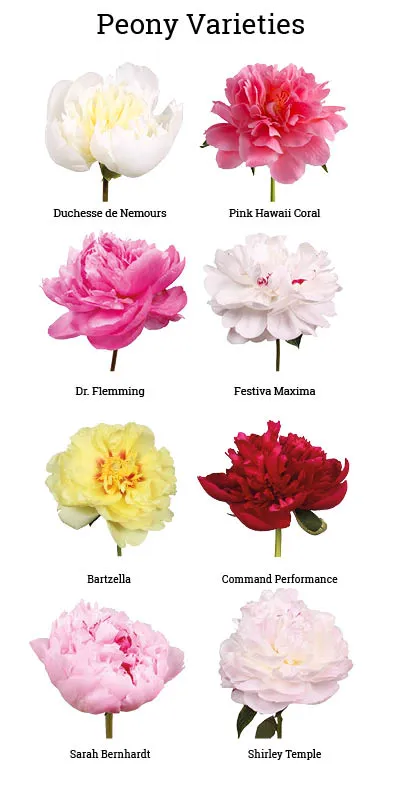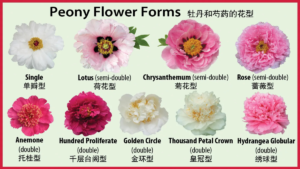Learn how to plant, grow, and care for peonies on your flower farm! From choosing the perfect location to harvesting stunning blooms, this guide has you covered.
Introduction: Peonies
Peonies are beloved for their stunning blooms and delightful fragrance, making them a favorite among flower farmers and gardeners alike. If you’re looking to cultivate these beautiful flowers on your flower farm, this comprehensive guide will walk you through everything you need to know about planting, growing, and caring for peonies. From selecting the perfect location to harvesting your blooms, we’ve got you covered.
Planting and Caring for Your Peonies
Choose the Right Location
Peonies are sun-worshippers, thriving in areas that receive at least 6 hours of direct sunlight daily. However, in very hot climates like the southern US, some afternoon shade can be beneficial to prevent blooms from scorching.
Well-draining soil is paramount. Peonies detest soggy roots, so avoid planting in low-lying areas or clay soil. If drainage is a concern, consider raised beds or amending the soil with compost or sand for better permeability.
Soil pH should ideally be slightly acidic, between 6.5 and 7.0. A simple soil test kit readily available at most garden centers will tell you your soil’s pH. If your soil leans too alkaline, you can amend it with peat moss or sulfur to lower the pH.
Peony Spacing
Peonies are long-lived perennials, and a mature plant can reach a good 3-4 feet in width and height. To avoid overcrowding and stunted growth, ensure proper spacing when planting. Aim for a distance of 3-4 feet between each peony plant, keeping in mind the variety you choose – some peonies naturally grow larger than others.
How to Plant Peony Roots
The best time to plant peonies is in early fall, ideally from September to October. This allows the roots to establish a strong network before winter dormancy.
- Dig a hole 2-3 times wider and deeper than the peony root itself.
- Mix compost or aged manure into the bottom of the hole for extra nutrients.
- Place the peony root carefully in the hole, ensuring the “eyes” (the pink or white buds) are facing upwards and positioned no deeper than 1-2 inches below the soil surface. Deeper planting can delay or even prevent flowering.
- Backfill the hole with the amended soil, gently tamping it down to remove air pockets.
- Water thoroughly to settle the soil and keep the roots hydrated.
- Apply a layer of mulch around the base of the plant (keeping it away from the stems) to retain moisture and suppress weeds.
Fall Peony Care
Fall is a crucial time for establishing healthy peonies. Here are some essential practices:
- Watering: Continue watering deeply throughout the fall, especially during dry spells, until the ground freezes.
- Fertilizing: Apply a light application of a balanced fertilizer in early fall before the first frost.
- Winter Mulch: Once the ground freezes, add a thick layer (4-6 inches) of mulch around the base of the plant to protect the roots from harsh winter temperatures.
Should You Disbud Your Peonies?
Peonies often produce multiple buds per stem. While tempting to let them all develop, disbudding (removing some of the buds) can be beneficial, especially for young plants or those with particularly large blooms. Here’s why:
- Larger blooms: By removing some buds, you encourage the plant to focus its energy on producing fewer, show-stopping flowers.
- Stronger stems: Disbudding reduces the weight on the stems, preventing them from bending or breaking under the weight of heavy blooms.
How to Disbud: Carefully pinch off unwanted buds when they are still small and green, leaving the largest and healthiest bud to develop.
When to Harvest Peonies
Harvesting peonies at the right time is crucial for enjoying their beauty indoors. Wait until the buds are soft to the touch and show some color before cutting them. Harvest in the early morning or late evening when the flowers are at their freshest.
“Marshmallow stage”: The ideal stage for cutting peonies is when they feel soft and yielding, similar to a marshmallow.
Color peeking through: The bud will start to show a hint of its color, and the outer petals (called sepals) may begin to separate slightly.
Early morning harvest: Plan to harvest your peonies early in the morning when they are fully hydrated and less prone to wilting.
Cut at an angle: Using sharp bypass shears, cut the stem at a 45-degree angle near the base of the plant, leaving enough foliage for healthy regrowth.
Dry Storing Peonies
If you want to extend the peony season or need to hold blooms for an event, dry storing peonies is the solution! Here’s how:
- Harvest at the correct stage: Select peonies in the “marshmallow stage”.
- Remove foliage: Strip all leaves from the stems.
- Wrap carefully: Wrap individual blooms in wax paper or tissue paper, ensuring they don’t touch each other.
- Refrigerate: Place the wrapped blooms horizontally in a refrigerator set at 34-38 degrees Fahrenheit. Peonies can be stored this way for up to 3-4 weeks.
- Rehydrate: When ready, unwrap the peonies and allow the stems to soak in room temperature water for several hours before using them. They should open beautifully!
How to Get Rid of Ants on Peonies
Peonies are notorious for attracting ants, but fear not! These harmless insects are primarily drawn to the sugary secretions on the buds, and don’t cause direct damage to the plant. Here are some ant control methods:
- Natural deterrents: Sprinkle diatomaceous earth, cinnamon, or coffee grounds around the base of the plant.
- Sticky tape: Wrap sticky tape around the stems, creating a barrier that ants can’t cross (sticky side out, of course!)
- Insecticidal soap: If the infestation is severe, spray peonies with insecticidal soap specifically formulated for outdoor use.
- Rinse off: Occasionally rinse the buds with a gentle stream of water to dislodge ants.
What are the different types of peonies and how do they differ in care?

According to the search results, there are two main types of peonies:
- Garden Peonies (Herbaceous Peonies):
- These are the most common type of peonies, known for their large, fragrant blooms in shades of white, pink, and red.
- They are perennials that die back to the ground each winter and regrow in the spring.
- Garden peonies prefer full sun and well-drained soil. They should be planted with the eyes (buds) 1/2 to 2 inches deep, depending on climate.
- In the fall, the foliage should be cut back after the first frost. A layer of mulch can help protect the roots over winter.
- Tree Peonies:
- Tree peonies have a woody, shrub-like growth habit and can reach 4-5 feet tall.
- Their massive, semi-double blooms can be up to 8 inches across in a variety of colors including red, pink, purple, and yellow.
- Tree peonies prefer partial shade and can tolerate more humidity than garden peonies.
- They should be planted deeper, with the graft 4-6 inches below the soil surface, so the herbaceous rootstock can die away.
- Tree peonies may need staking to support their large blooms, unlike the self-supporting garden peonies.
In summary, the main differences in care are the planting depth, sun exposure preferences, and need for staking between the two peony types. Both require well-drained soil and benefit from fall cleanup and mulching.
How often should peonies be watered and fertilized?
According to the search results, here are the key points on watering and fertilizing peonies:Watering:
- Peonies prefer consistent moisture, especially during active growth periods. They typically need about 1 inch of water per week.
- During dry spells or hot weather, peonies may need more frequent watering, up to once a week.
- It’s best to water the soil around the plant rather than directly on the foliage.
- Overwatering can lead to issues like root rot and fungal diseases, so it’s important not to overwater.
Fertilizing:
- Peonies should be fertilized once a year, typically in early spring just after bloom season has ended.
- A balanced fertilizer or one with a higher phosphorus ratio (like 5-10-10) is recommended to promote robust growth and vibrant blooms.
- Organic fertilizers like compost or bone meal can also be beneficial, as they release nutrients slowly over time.
- Avoid over-fertilizing, as too much nitrogen can lead to excessive foliage growth at the expense of flowers.
- Fertilizer should be applied around the drip line of the plant, not directly on the crown.
In summary, peonies generally need about 1 inch of water per week, with adjustments for dry or hot weather. They should be fertilized once annually in early spring with a balanced or phosphorus-rich fertilizer, being careful not to over-fertilize.
What type of fertilizer is best for peonies?
Based on the search results, the best type of fertilizer for peonies is: A balanced, slow-release granular fertilizer with an NPK ratio slightly lower in nitrogen (N) than phosphorus (P) and potassium (K).The ideal NPK ratios recommended for peonies are:
- 3-5-5
- 3-4-5
- 2-5-4
These ratios provide the right balance of nutrients to support healthy foliage growth, strong root development, and abundant blooms without encouraging excessive leafy growth at the expense of flowers.Some specific examples of good fertilizer options for peonies include:
- Balanced, slow-release perennial fertilizers like Flower-Tone or Jobe’s Organics Annuals & Perennials
- Bone meal, which provides phosphorus to promote flowering
- Compost or well-rotted manure, which adds a range of slow-release nutrients
The key is to avoid fertilizers high in nitrogen, as this can lead to lush foliage but fewer blooms. Applying the fertilizer in early spring or just after flowering, and keeping it a few inches away from the plant crown, is also recommended.
Conclusion
Peonies are a worthy investment for any flower farm. With their stunning blooms, extended vase life, and minimal maintenance requirements, they are the perfect blend of beauty and practicality.
Remember, patience is key with these magnificent perennials. By following the tips outlined in this guide, you’ll be well on your way to growing a field of peony perfection!
FAQs
A: It can take peonies 2-3 years to reach maturity and produce an abundance of flowers. Don’t be discouraged by a slow start – they’ll reward your patience with stunning blooms for decades!
A: While peonies prefer being planted in the ground, it’s possible to grow them in large containers (at least 20 gallons) with proper care. Choose dwarf varieties and ensure the container has excellent drainage.
A: Proper planting depth is crucial for peonies. Ensure the eyes (buds) on the root are positioned no more than 1-2 inches below the soil surface.
A: Peonies with large, double blooms may benefit from support to prevent stems from flopping over, especially after heavy rain. Circular plant supports or peony rings work well.
A: Here are a few reasons why peonies may fail to bloom:
Too deep planting
Insufficient sunlight
Juvenile plants
Competition from other roots or overcrowding
